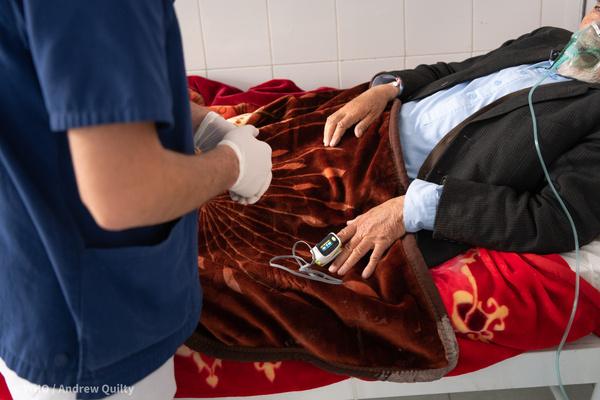Two new studies highlight the impact that the COVID-19 pandemic has had on antibiotic use and resistance.
In one study, data gathered by researchers from the World Health Organization (WHO) confirms what previous research has shown—globally high rates of antibiotic use in COVID-19 patients despite low rates of suspected bacterial infections. In the other, a team led by researchers from the National Institutes of Health (NIH) found that rates of hospital-acquired, multidrug-resistant infections at US hospitals remain well above pre-pandemic levels.
Both studies are being presented at the upcoming European Society of Clinical Microbiology and Infectious Diseases (ESCMID) Global Congress in Barcelona, Spain.
Of patients with severe COVID, 81% got antibiotics
The WHO data, collected through the WHO Global Clinical Platform, shows that, among 592,898 COVID-19 patients hospitalized in 65 countries from January 2020 through March 2023, antibiotic use ranged from 83% in the WHO Eastern Mediterranean Region to 32.8% in the Western Pacific Region. Overall, three of four COVID-19 patients received antibiotics, despite the fact that antibiotics provide no benefit for the viral illness.
The highest rate of antibiotic use was seen among patients with severe or critical COVID-19, 81% of whom received antibiotics. But even in patients with mild or moderate COVID, antibiotics were commonly used, with rates as high 79% in the African Region. Empiric treatment was common, ranging from 55% in patients with mild/moderate COVID-19 to 69% in severe critical cases.
While antibiotic prescribing rates for COVID-19 declined over time in Europe and the Americas from the beginning of the pandemic through 2022, they increased in Africa.
Although frequent use of antibiotics in the early months of the pandemic—when hospitals were overwhelmed and few treatment options were available—has been well documented, the continued use of antibiotics for COVID well into the pandemic is concerning. The WHO says they're concerned that this extensive overuse of antibiotics is contributing to the "silent spread" of antimicrobial resistance (AMR).
Prescription of 'Watch' antibiotics as high as 94%
In another concerning finding, the data also show that antibiotics with an increased risk of promoting resistance—known as "Watch" antibiotics under the WHO's AWaRE (Access, Watch, and Reserve) classification system—were frequently prescribed for COVID-19 patients in the Eastern Mediterranean Region (93.8%), the Region of the Americas (90.8%), and the African Region (91.1%).
But, as has been found in previous studies, there is little reason to prescribe antibiotics for patients with COVID-19. Suspected bacterial co-infections—which might justify use of antibiotics in some cases—were reported in only a fraction (8%) of COVID-19 patients. Higher rates of bacterial co-infections were reported in the Region of the Americas (14.1%) and the Eastern Mediterranean Region (8.8%).
Unsurprisingly, antibiotics did not improve clinical outcomes for COVID-19 patients. In fact, an analysis of patients without suspected or confirmed bacterial infections found that patients with mild/moderate COVID-19 who received empiric antibiotic therapy had an 80% increased mortality risk (adjusted hazard ratio [aHR], 1.80; 95% confidence interval [CI], 1.36 to 2.38) compared with those didn't receive antibiotics.
Patients with severe/critical COVID-19 who received antibiotics had a 16% increased risk of death (aHR, 1.16; 95% CI, 1.08 to 2.84).
"When a patient requires antibiotics, the benefits often outweigh the risks associated with side effects or antibiotic resistance. However, when they are unnecessary, they offer no benefit while posing risks, and their use contributes to the emergence and spread of antimicrobial resistance," Silvia Bertagnolio, MD, WHO unit head for surveillance, evidence, and laboratory strengthening in the Division for AMR, said in a WHO press release.
"These data call for improvements in the rational use of antibiotics to minimize unnecessary negative consequences for patients and populations," she added.
Rise in resistant, hospital-acquired infections
Meanwhile, data collected from 120 US hospitals from January 2018 through December 2022 illustrate how AMR surged during the pandemic, driven largely by dramatic increases in hospital-acquired infections.
In the study, researchers examined all adult hospitalizations over the period for culture-confirmed infection by six pathogens: methicillin-resistant Staphylococcus aureus (MRSA), vancomycin-resistant Enterococcus (VRE), extended-spectrum cephalosporin-resistant Enterobacterales (ECR), carbapenem-resistant Enterobacterales (CRE), Acinetobacter baumannii (CRAB), and Pseudomonas aeruginosa (CR-PA). Hospital-acquired infections were defined as those that occurred after 3 days of hospitalization.
These data call for improvements in the rational use of antibiotics to minimize unnecessary negative consequences for patients and populations.
The researchers wanted to provide an update to a previous report by the Centers for Disease Control and Prevention (CDC). The report, published in 2022, showed alarming increases in the six pathogens at US hospitals during first year of the pandemic, resulting in a 15% overall increase in drug-resistant infections and deaths from 2019 through 2020.
The NIH-led study found the overall prevalence of AMR infections increased by 6.3% during the pandemic, driven mainly by hospital-acquired infections, which rose 32.4%, compared with a 1.4% increase in community-acquired infections. Among the hospital-acquired infections, the largest increases were seen for CRAB (a 160.0% increase), CRE (63.6%), CR-PA (54.5%), and ECR (50%). Conversely, community-acquired MRSA infections fell 10% during the pandemic, a result the researchers believe is linked to reduced social interactions.
Multiple factors at play
As with the CDC report, the researchers believe the surge in multidrug-resistant, hospital-acquired infections is likely the result of a combination of pandemic-related factors.
"It is likely that surges in severely ill COVID-19 patients during the pandemic corresponded with significant surges in antibiotic use and challenges following infection and prevention control protocols in strained hospitals," lead author Christina Yek, MBBCh, of the National Institute of Allergy and Infectious Diseases, said in an ESCMID press release. "In addition, hospitals may have experienced shortages of personal protective equipment, while treating sicker patients who were more likely to require the use of medical devices like ventilators, which would have added to the spread of antimicrobial-resistant infections."
Yek and her colleagues also found that the hospitals that saw the largest surges in severely ill COVID-19 patients had the largest increases in hospital-acquired AMR infections.
And while the overall prevalence of AMR infections in US hospitals returned to pre-pandemic levels (a 0.2% increase) by the end of 2022, hospital-acquired AMR infections remained 13% above baseline, largely because of continued increases in carbapenem-resistant gram-negative pathogens. From March to December 2022, CRE, CRAB, and CR-PA infections were 81%, 43%, and 38% above pre-pandemic levels.
Yek said the persistence of these infections is concerning.
"More action is needed to protect people, especially from difficult-to-treat hospital-acquired gram-negative infections that remain concerningly high," she said.






















